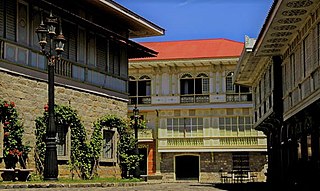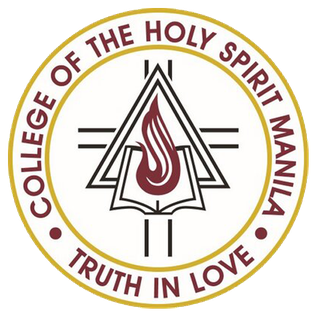
The University of the Philippines Diliman, also referred to as UP Diliman or simply University of the Philippines (UP), is a public, coeducational, research university located in Diliman, Quezon City, Philippines. It was established on February 12, 1949, as the flagship campus and seat of administration of the University of the Philippines System, the premier and national university of the Philippines.

The Philippine General Hospital, simply referred to as UP–PGH or PGH, is a tertiary state-owned hospital administered and operated by the University of the Philippines Manila. It is designated as the National University Hospital, and the national government referral center. It stands within a 10-hectare (25-acre) site located at the UP Manila Campus in Ermita, Manila. PGH has 1,100 beds and 400 private beds, and has an estimated of 4,000 employees to serve more than 600,000 patients every year.

Intramuros, is the 0.67-square-kilometer (0.26 sq mi) historic walled area within the city of Manila, the capital of the Philippines. It is administered by the Intramuros Administration with the help of the city government of Manila.

The University of the Philippines Manila is a public, coeducational, research university located in Ermita, Manila, Philippines. It is known for being the country's center of excellence in the health sciences, including health professional education, training, and research. It is the oldest of eight constituent universities of the University of the Philippines System, and predates the founding of UP by three years. It was originally established on December 1, 1905, as the Philippine Medical School and later renamed as the UP College of Medicine and Surgery on June 10, 1907. In 1983 it was renamed as University of the Philippines Manila.

The University of the East, also known as UE, is a private university located in Manila, Philippines. Founded in 1946, business tycoon Lucio Tan acquired the university in 1990. UE was once labeled as the "largest university in Asia" when its enrollment in the past reached over 65,000 students.

The De La Salle Santiago Zobel School, also referred to by its acronym DLSZ or De La Salle Zobel, is a private Catholic basic education institution for boys and girls run by the Philippine District of the De La Salle Brothers in Muntinlupa, Metro Manila, Philippines. It was opened in 1978 by the De La Salle Brothers because of the increasing number of students in the grade school department of the former De La Salle College in Manila.

De La Salle University–Dasmariñas, also referred to by its acronym DLSU-D or La Salle–Dasma, is a private Roman Catholic, Lasallian co-educational secondary and higher education institution run by the De La Salle Brothers of the Philippine District of the Christian Brothers in Dasmariñas, Philippines. It is a member of De La Salle Philippines, a network of 16 Lasallian educational institutions.

The PHINMA – University of Iloilo is a private, nonsectarian, coeducational institution in Iloilo City, Philippines. It was established in 1947 by the López family of Iloilo who founded the broadcasting giant ABS-CBN Corporation as Iloilo City Colleges. The university was later acquired by the business conglomerate group PHINMA Industries, and its current operations and management is controlled by the said company under its arm, PHINMA Education Network.

The University of the Philippines Mindanao is a public research university, serving as the sixth constituent unit of the University of the Philippines System. UP Mindanao is the only constituent university of the UP System that was created through legislative action. Republic Act 7889 formally created UP Mindanao on February 20, 1995. The university was later formally recognized as an independent constituent university by the Board of Regents of the UP System on March 23, 1995. Its main focus of education is Mindanao studies through an affirmative action program in the Autonomous Region in Muslim Mindanao to attract Muslims and Lumad students, aside from the marginalized and deserving students. The university was first named University of the Philippines in Mindanao to declare the arrival of the state university in Mindanao after a long period of waiting by eager alumni and students. This was later replaced to its present name due to the request of the UP System for formalities' sake.

The architecture of the Philippines reflects the historical and cultural traditions in the country. Most prominent historic structures in the archipelago are influenced by Austronesian, American architectures.

The Manila Metropolitan Theater, also known as the Metropolitan Theater, abbreviated as the MET, is a historic Philippine Art Deco building located in Plaza Lawton in Ermita, Manila. It is recognized as the forefront of the Art Deco architectural style in the Philippines.

Manila Central University (MCU), formerly known as the Escuela de Farmacia del Liceo de Manila, is a private, non-sectarian, stock basic and higher education institution located on EDSA, Caloocan, Philippines. It was founded in 1904 by Dr. Alejandro M. Albert, who also was its first director.

The Polytechnic University of the Philippines is a coeducational state university in Manila, Philippines. It was founded on 19 October 1904, as the Manila Business School (MBS) and as part of Manila's public school system. It was eventually promoted to a chartered state university in 1978, by virtue of Presidential Decree 1341. PUP has more than 20 Campuses across Central Luzon, Southern Luzon and Metro Manila. With over 80,000 enrolled students, PUP claims to be the largest state university in the Philippines by student population.

The Manila City Hall is the official seat of government of the City of Manila, located in the historic center of Ermita, Manila. It is where the Mayor of Manila holds office and the chambers of the Manila City Council is located. It was originally intended to be a part of a national government center envisioned by Daniel Burnham in the 1900s. Although the dream plan was not fully implemented, some buildings for the proposed government center were constructed, including the Old Legislative Building, and the Agriculture and Finance Buildings.

Far Eastern University, also referred to by its acronym FEU, is a private research non-sectarian university in Manila, Philippines. Created by the merger of Far Eastern College and the Institute of Accounts, Business and Finance, FEU became a university in 1934 during the term of its first president, Nicanor Reyes Sr.

The College of the Holy Spirit Manila, or simply CHSM, was a private, Catholic education institution founded and ran by the Missionary Sisters Servants of the Holy Spirit in Manila, Philippines. Founded in 1913, College of the Holy Spirit Manila was established originally as Holy Ghost College through the invitation of then Manila Archbishop Jeremias Harty. Located initially on Legarda Street, the campus later moved along Mendiola Street, inside the Malacañang Palace Complex. It is one of the schools which comprises the Mendiola Consortium (MC) for academic cooperation along with Centro Escolar University Manila, La Consolacion College Manila, San Beda College Manila, and St. Jude Catholic School.
What originally started as the Manila Business School that opened in 1904, is now the Polytechnic University of the Philippines, the largest university system in the country by enrollment.

Dentistry in the Philippines can be divided into five periods of dental practice. Using the timeline of Philippine history as a template, they are: the Pre-Spanish era, the Spanish era, the American era, the Japanese occupation era and the independent Philippine-Republics era.
The Ninoy Aquino Library and Learning Resources Center (NALLRC) is the library system of the Polytechnic University of the Philippines composed of libraries providing services to the PUP System. Its headquarters is in the building of the same name, located in Manila, Philippines. NALLRC offers various services and development of programs to its clientele.

The National Museum of Natural History is the national natural history museum of the Philippines. It is located along Agrifina Circle in Rizal Park, Manila.



















